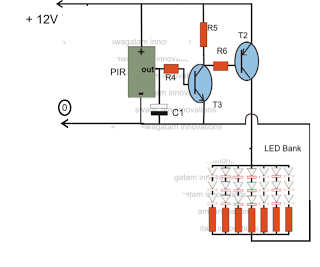
PIR Controlled LED Driver Circuit

The circuit is an LED driver that responds to ambient light as well as the presence of an intruder, varying its illumination accordingly. Additionally, it includes an ambient light sensor to turn the LEDs on and off, and a proximity sensor that increases brightness to full when someone approaches, then reduces it to half or 30% brightness after 30 seconds. This circuit is intended for commercial use and needs to be simple and cost-effective. The upper section of the circuit features a proximity sensor. The transistors T2 and T3 are configured as high-gain amplifiers capable of detecting even minute voltages from the PIR sensor.
The LED driver circuit is designed to provide adaptive lighting based on environmental conditions and user presence. The primary components include an ambient light sensor, a proximity sensor, and a series of transistors configured to manage the LED output effectively.
The ambient light sensor operates using a photodiode or LDR (Light Dependent Resistor) to measure the intensity of surrounding light. When the ambient light falls below a predetermined threshold, the sensor activates the LED driver circuit, illuminating the LEDs to provide necessary lighting. This feature ensures energy efficiency by preventing unnecessary lighting during daylight hours.
The proximity sensor, typically a passive infrared (PIR) sensor, detects motion within its field of view. When an intruder or person approaches, the PIR sensor sends a signal to the transistor stage of the circuit. Transistors T2 and T3, configured as high-gain amplifiers, amplify this signal to trigger the LEDs to switch to full brightness, ensuring visibility and security.
To implement the dimming functionality, a timer circuit can be integrated, which is activated upon detecting motion. After a set duration of 30 seconds without further motion detection, the circuit reduces the brightness of the LEDs to either half or 30%, depending on the design specifications. This feature not only conserves energy but also prolongs the lifespan of the LED components.
The overall design emphasizes simplicity and cost-effectiveness, making it suitable for commercial applications. The use of readily available components, such as common transistors and inexpensive sensors, contributes to the circuit's affordability while maintaining functionality. The integration of these elements creates a versatile LED driver circuit capable of adapting to varying lighting conditions and user presence, fulfilling the requirements for a practical and efficient lighting solution.The circuit is a LED driver which responds to ambient lightas wellas to the presence of any intruder, and varies its illumination accordingly, lets know more. Also I would like to have an ambient sensor to switch on and off and a proximity sensor to switch to full brightness if some one approaches and to switch to half or 30% brightness after 30 s
econds. I need this for commercial use. I need asimplecost effective circuit. I have been following the blog and am sure that you know the subject. Please get back to me. " The uppersectionis aproximitysensor circuit. The transistors T2 and T3 are configured as high gainamplifierand is able to sense even minute voltages from the PIR sensor. 🔗 External reference
The LED driver circuit is designed to provide adaptive lighting based on environmental conditions and user presence. The primary components include an ambient light sensor, a proximity sensor, and a series of transistors configured to manage the LED output effectively.
The ambient light sensor operates using a photodiode or LDR (Light Dependent Resistor) to measure the intensity of surrounding light. When the ambient light falls below a predetermined threshold, the sensor activates the LED driver circuit, illuminating the LEDs to provide necessary lighting. This feature ensures energy efficiency by preventing unnecessary lighting during daylight hours.
The proximity sensor, typically a passive infrared (PIR) sensor, detects motion within its field of view. When an intruder or person approaches, the PIR sensor sends a signal to the transistor stage of the circuit. Transistors T2 and T3, configured as high-gain amplifiers, amplify this signal to trigger the LEDs to switch to full brightness, ensuring visibility and security.
To implement the dimming functionality, a timer circuit can be integrated, which is activated upon detecting motion. After a set duration of 30 seconds without further motion detection, the circuit reduces the brightness of the LEDs to either half or 30%, depending on the design specifications. This feature not only conserves energy but also prolongs the lifespan of the LED components.
The overall design emphasizes simplicity and cost-effectiveness, making it suitable for commercial applications. The use of readily available components, such as common transistors and inexpensive sensors, contributes to the circuit's affordability while maintaining functionality. The integration of these elements creates a versatile LED driver circuit capable of adapting to varying lighting conditions and user presence, fulfilling the requirements for a practical and efficient lighting solution.The circuit is a LED driver which responds to ambient lightas wellas to the presence of any intruder, and varies its illumination accordingly, lets know more. Also I would like to have an ambient sensor to switch on and off and a proximity sensor to switch to full brightness if some one approaches and to switch to half or 30% brightness after 30 s
econds. I need this for commercial use. I need asimplecost effective circuit. I have been following the blog and am sure that you know the subject. Please get back to me. " The uppersectionis aproximitysensor circuit. The transistors T2 and T3 are configured as high gainamplifierand is able to sense even minute voltages from the PIR sensor. 🔗 External reference





